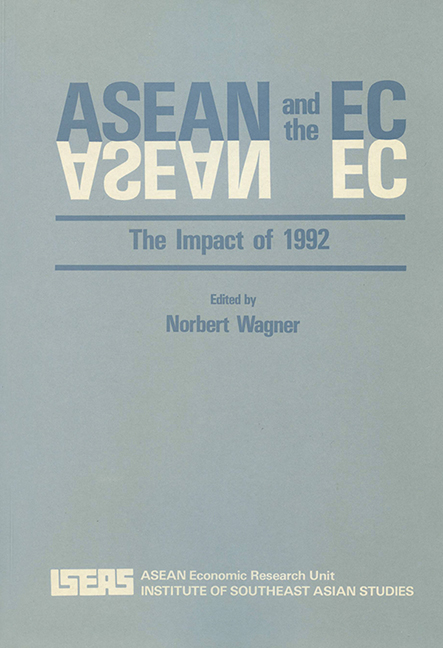Book contents
- Frontmatter
- Contents
- List of Tables
- List of Figures
- Acknowledgements
- PART I INTRODUCTION
- PART II COMPLETING THE EC INTERNAL MARKET
- II Completing the EC Internal Market: An Update and Problems Ahead
- III The EC Internal Market Programme: Implications for External Trade
- IV The EC Internal Market: Implications for Capital Flows
- PART III IMPLICATIONS FOR ASEAN
- Contributors
II - Completing the EC Internal Market: An Update and Problems Ahead
from PART II - COMPLETING THE EC INTERNAL MARKET
Published online by Cambridge University Press: 09 November 2017
- Frontmatter
- Contents
- List of Tables
- List of Figures
- Acknowledgements
- PART I INTRODUCTION
- PART II COMPLETING THE EC INTERNAL MARKET
- II Completing the EC Internal Market: An Update and Problems Ahead
- III The EC Internal Market Programme: Implications for External Trade
- IV The EC Internal Market: Implications for Capital Flows
- PART III IMPLICATIONS FOR ASEAN
- Contributors
Summary
This chapter first deals with general issues such as a proper delineation of 1992, a bench-mark definition of “internal market” and the basic principles employed in the 1992 exercise. This prepares the ground for the achievements to date, major issues today, and achievements expected by 1993.
What Is 1992?
The following attempts to pin down how 1992 can be given substance and where the demarcation lines may be drawn. However, this approach should avoid a too rigid and static view as the dynamism in the 1992 process is forceful and has not yet petered out.
Three Meanings of the Common Market
The colloquial English name for the European Community (EC) is the “common market”. Indeed, that is what the Treaty of Rome sets out to construct as one of the two means to achieve the four economic aims as well as the political aim of Article 2. Since the common market is the very core of the EC enterprise, we must assume that Member States, public opinion, and decision-makers have a fairly good notion of what it is they are striving for. Even a cursory inspection shows that this is unfortunately far from being the case.
The common market before the White Paper: The Treaty of Rome does not define the common market. Lawyers have made up for this by employing the operational formula of the four freedoms, the free movement of products, services, labour, and capital. There can be no doubt that the idea of the four freedoms is echoed in the Treaty of Rome to a considerable extent. However, since Europe has mixed economies, with governments regulating some markets while intervening in others, the necessary condition of the four freedoms is not a sufficient one for a common market to come into being. On the sufficient conditions as specified in the Treaty of Rome, reputable lawyers have expressed different views.
- Type
- Chapter
- Information
- ASEAN and the ECThe Impact of 1992, pp. 21 - 71Publisher: ISEAS–Yusof Ishak InstitutePrint publication year: 1991



